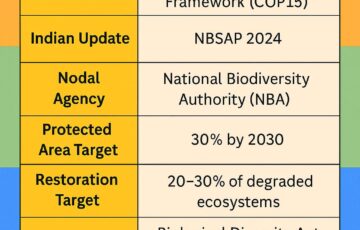IMPACT OF TRUMP’S TARIFFS ON INDIA WILL BE LOWER THAN FOR OTHER COUNTRIES, INCLUDING CHINA
Why in the news?
- Tariffs are likely being used as aggressive opening moves in a broader negotiation strategy, especially in bilateral contexts.
- The Trump administration’s approach, while strategic, tends to undermine established international institutions.
- It erodes mutual trust between trading partners and challenges the norms of multilateral cooperation.
Understanding Trump’s Trade Approach and Its Context
- Trump’s Vision of “Greatness”: Donald Trump’s slogan “Make America Great Again” reflects a desire to restore perceived lost economic dominance and national pride, often with protectionist undertones.
- Underlying Motives: The slogan also serves as a cover for less noble goals, such as nationalist economic policies, protectionism, and inward-looking governance.
- Chaotic Policy Implementation: His administration’s approach has been marked by unpredictability and disruption, even as it pursues strategic objectives like trade rebalancing.
- New Tariff Policies (April 2 Announcement): While dramatic, the tariffs seem relatively moderate within the larger context of Trump’s confrontational trade agenda.
US Role in Global Trade:
Historically, the US has led in promoting an open global economy and often faced challenges in securing reciprocal openness from others.
- Post-WWII Trade Asymmetries: Global trade rules initially favored the US’s dominant post-WWII position, building in asymmetries that later frustrated American policymakers.
- Delayed Formation of WTO: Unlike the IMF and World Bank, the WTO took nearly 50 years to be established, highlighting the complexity of global trade governance.
- Evolving Global Economy: As other nations recovered or industrialized, they gained competitive advantages in sectors like manufacturing, altering the global economic balance.
- American Frustration: The US, once dominant, now feels disadvantaged in a system that offers others greater market access – a central theme in Trump’s trade rhetoric.
- Shifts in Manufacturing: Countries like Japan developed strong industries over time, often competing with or surpassing US counterparts.
- Job Loss and the Rust Belt: Globalization and trade openness contributed to US job losses in manufacturing, with regions like the Rust Belt suffering heavily – a key source of Trump’s political support.
- Lack of Mitigation Efforts: The US has done little to support workers affected by globalization, intensifying economic discontent and shaping political outcomes.
Analysis of Trump’s Tariff Strategy and Its Implications
- Tariffs Won’t Solve Structural Issues: Trump’s tariff policies are unlikely to address the deeper challenges of structural economic change driven by growth, technology, and globalization.
- Limited Economic Impact: The baseline 10% tariff announced on April 2 could raise up to $200 billion, but most of this cost will fall on US households, functioning as a regressive consumption tax.
- Minimal Job Gains: The impact on US manufacturing and employment is expected to be marginal, despite the rhetoric of job creation.
- Targeted Tariff Strategy: Higher tariffs are being applied selectively to countries perceived as maintaining high trade barriers.
- India as a Case Study:
- Trump’s announcement exaggerated India’s average tariff as 52%, proposing a “reciprocal” tariff of 26%.
- However, the USTR’s own report (March 31) puts India’s actual average applied tariff at 17%, and 39% for agricultural products—much lower than claimed.
- Questionable Data and Justifications: Analysts have criticized the administration’s figures as lacking sound conceptual and empirical grounding.
- Aggressive Opening Positions: The exaggerated figures and high tariffs may simply be strategic starting points in a broader negotiation process.
- Potential for Bilateral Negotiations: It’s likely the real goal is to initiate bilateral talks aimed at securing better market access for US goods.
- Optimistic Scenario: If successful, the process could lead to an overall reduction in global trade barriers, improving access for American exports currently restricted by tariffs or other barriers.
India’s Position and Strategy Amid Trump’s Tariff Policies
- Early Engagement in Negotiations: India has already begun navigating the negotiation process in response to Trump’s tariffs.
- Reluctance Toward Trade Openness: Despite over 30 years of liberalisation, India remains hesitant to fully open its markets to trade.
- High Tariff Profile: The USTR report identifies India as having the highest tariffs among major economies.
- Political Motivation – Protecting Farmers: Domestic political considerations, especially the need to protect farmers, have shaped India’s tariff policies.
- Inefficiencies in Tariff Strategy: India’s use of tariffs to support “infant industries” has often lacked consistency and effectiveness.
- Preference for Bilateralism: India has largely avoided multilateral trade deals under the WTO, opting instead for bilateral or regional agreements.
- Preparedness for Trump’s Approach: India’s experience with bilateral deals may position its negotiators to handle the Trump-style bilateral pressure more effectively.
- Need for Strong Response: Given that the US is India’s largest export market, a firm and strategic response is essential.
- US Capacity Constraints: The US may be stretched thin by having to negotiate with multiple countries and blocs simultaneously, with the EU and China likely taking precedence over India.
- Wider Impact of Trump Tariffs:
- They introduce global uncertainty and raise transaction costs.
- Some trade will decline or be diverted.
- Supply chains will face disruption and increased costs.
- Global economic growth may slow, which indirectly affects India.
- India’s Relative Insulation: Because India has not deeply integrated into global trade, it may suffer less immediate damage compared to countries like China (which could see its short-term growth halved).
Strategic Outlook for India:
The impact of Trump’s tariffs is more of a wrinkle than a rupture in India’s long-term strategy, which should focus on:
- Strengthening bilateral trade agreements
- Encouraging foreign investment and technology inflows
- Integrating more deeply into global production and value chains
Way Forward for India Amid Trump Tariffs
- Strengthen Bilateral Trade Negotiations: Leverage experience with piecemeal trade deals to negotiate reciprocal market access with the US and other key partners.
- Push for Evidence-Based Tariff Justifications: Challenge inflated or misleading claims (like the 52% tariff myth) with data from credible sources, including the USTR’s own report.
- Protect Core Interests Strategically: Maintain necessary protections for sensitive sectors (like agriculture), but streamline tariffs where they hinder competitiveness.
- Use the Opportunity to Reform Tariff Structures: Rationalize tariff policies to align with industrial growth goals—move from arbitrary protectionism to strategic support.
- Diversify Export Destinations: Reduce over-reliance on the US market by expanding trade with ASEAN, Africa, Latin America, and the EU.
- Deepen Integration into Global Supply Chains: Attract foreign investment and technology to become a key node in global value chains, especially in manufacturing and services.
- Maintain Multilateral Leverage: While bilateralism is practical, keep multilateral platforms like the WTO in play to avoid being cornered in one-on-one negotiations.
- Prepare for Retaliatory Fallout: Create contingency plans for industries that may be hit by retaliatory tariffs or disrupted trade flows.
- Enhance Trade Negotiation Capacity: Invest in building a skilled trade negotiation team capable of dealing with complex and aggressive negotiation tactics.
- Communicate Policy Consistency: Send clear signals to global investors and trading partners that India is committed to predictable and rules-based trade engagement.
Mains Question (250 words):
Critically examine the impact of Trump-era tariff policies on global trade dynamics, with a special focus on India’s response strategies and the future of bilateral and multilateral trade engagements.





